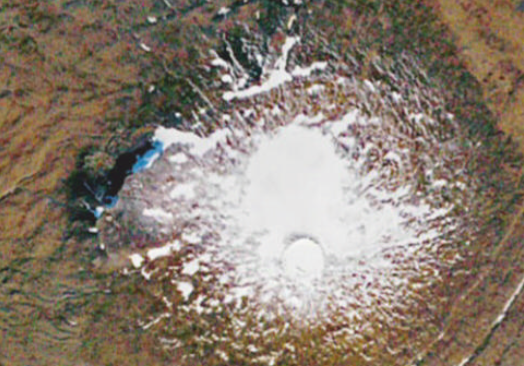It also held the water that fed local streams and sustained the local population, pouring it out as if from buckets balanced on the yoke of the mountain. Its water was very cold, very old, and pure. Icelanders might overlook Ok, but those who had drunk its water remembered with pleasure how it tasted, and imagined the little glacier would always go on giving.
它还储存着当地溪流的水,维持着当地居民的生活,像是从平衡在山上的桶里倒出来一样。那的水非常凉,非常古老,也很纯净。冰岛人可能会忽略OK岛,但是那些喝过它的水的人愉快地记得它的味道,想象着这个小冰川会不断的融化。
In 1890 geologists estimated that Ok covered 1,600 hectares, or 6.2 square miles. (On one map of 1901 it seemed to spread even farther, to 3,800 hectares.) Gradually and quietly, through the 20th century, it dwindled away. In 1945, it covered only 500 hectares; in 1978, 300; in 2012, about 70. The next year Oddur Sigurosson, a glacier expert at the Meteorological Office, paid his "good friend" a close visit. What he found was, by then, obvious: the snow on Ok was melting faster than it could be replaced.
1980年,地理学家估计OK岛占地1600公顷,或6.2平方英里。(在1901年的一张地图上,它似乎更大,有3800公顷。) 逐渐地,隐秘地度过20世纪后,它就要消失了。1945年,它仅仅占地500公顷;1978年为300公顷;2012年只有大约70公顷。第二年,气象局的冰川专家奥杜尔·西古德松拜访了他的“好朋友”。那时,他的发现是显而易见的:OK岛上的雪融化的速度快的无法弥补。

The ice had become so thin that "he" was no longer moving. Mr Sigurosson later recorded the death on an official certificate, attributing it to "excessive summer heat caused by humans". Not many of those humans seemed to notice, in Iceland or elsewhere. Ok had never drawn the tourists and the snowmobilers. So as it shrank yet more, to a patchy snowfield and a crater lake, there was no general outcry.
冰变得太薄了,他不能再动了。西古德松先生后来将死亡记录在官方证书上,将其归因为“由人类带来的过量夏热”。不论在冰岛还是别的地方,没有多少人注意到这件事情。OK从没吸引到游客或驾雪车的人。因此,当它进一步缩小,变成一片零散的雪地和一个火山口湖时,并没有引起普遍的抗议。
译文由可可原创,仅供学习交流使用,未经许可请勿转载。













